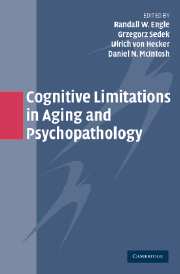Book contents
- Frontmatter
- Contents
- List of Contributors
- Preface
- Acknowledgments
- 1 Cognitive Limitations in Aging and Psychopathology: An Introduction and a Brief Tutorial to Research Methods
- SECTION I WORKING MEMORY AND COGNITIVE FUNCTIONS
- SECTION II AGING AND PSYCHOPATHOLOGY OF COGNITIVE CONTROL
- 5 The Aging of Cognitive Control: Studies of Conflict Processing, Goal Neglect, and Error Monitoring
- 6 Cognitive Control and Schizophrenia: Psychological and Neural Mechanisms
- 7 Aging and Varieties of Cognitive Control: A Review of Meta-Analyses on Resistance to Interference, Coordination, and Task Switching, and an Experimental Exploration of Age-Sensitivity in the Newly Identified Process of Focus Switching
- 8 An Ecological Approach to Studying Aging and Dual-Task Performance
- 9 Cognitive Performance After Preexposure to Uncontrollability and in a Depressive State: Going with a Simpler “Plan B”
- SECTION III ATTENTION, INHIBITION, AND REASONING PROCESSES
- Name Index
- Subject Index
- References
5 - The Aging of Cognitive Control: Studies of Conflict Processing, Goal Neglect, and Error Monitoring
Published online by Cambridge University Press: 20 May 2010
- Frontmatter
- Contents
- List of Contributors
- Preface
- Acknowledgments
- 1 Cognitive Limitations in Aging and Psychopathology: An Introduction and a Brief Tutorial to Research Methods
- SECTION I WORKING MEMORY AND COGNITIVE FUNCTIONS
- SECTION II AGING AND PSYCHOPATHOLOGY OF COGNITIVE CONTROL
- 5 The Aging of Cognitive Control: Studies of Conflict Processing, Goal Neglect, and Error Monitoring
- 6 Cognitive Control and Schizophrenia: Psychological and Neural Mechanisms
- 7 Aging and Varieties of Cognitive Control: A Review of Meta-Analyses on Resistance to Interference, Coordination, and Task Switching, and an Experimental Exploration of Age-Sensitivity in the Newly Identified Process of Focus Switching
- 8 An Ecological Approach to Studying Aging and Dual-Task Performance
- 9 Cognitive Performance After Preexposure to Uncontrollability and in a Depressive State: Going with a Simpler “Plan B”
- SECTION III ATTENTION, INHIBITION, AND REASONING PROCESSES
- Name Index
- Subject Index
- References
Summary
Over the past two decades, constructs bearing a strong conceptual resemblance to currently popular ideas related to cognitive control or the ability to regulate the information processing system in accordance with the goals of the individual have dominated models of cognitive aging. Hasher and Zacks (1979) argued that age-related declines across various domains of cognition result from reductions in the efficiency of effortful or controlled processes. More recently, these authors refined their position, arguing that age-related declines in the efficiency of inhibitory processes that allow one to modulate the influence of task irrelevant information were one of the primary causes of age-related disruptions in higher order cognition (Hasher & Zacks, 1988). Craik and Byrd (1982) argued that age-related declines in processing resources (i.e., working memory capacity or speed of processing) are largely responsible for age-related declines in cognition. The early paper of Hasher and Zacks (1979) and that of Craik and Byrd (1982) provided the foundation for extensive work during the 1980s and 1990s, demonstrating that many of the effects of age on higher order cognition are mediated by age-related variance in processing resource variables (see Park & Schwartz, 2000; Salthouse, 1996). During the same period, other investigators demonstrated that individual differences in processing resources, such as working memory capacity, were also good predictors of complex cognitive activity including reading and language comprehension in college-aged individuals (for a review see Engle, 1996).
- Type
- Chapter
- Information
- Cognitive Limitations in Aging and Psychopathology , pp. 97 - 121Publisher: Cambridge University PressPrint publication year: 2005
References
- 2
- Cited by



